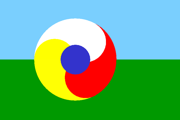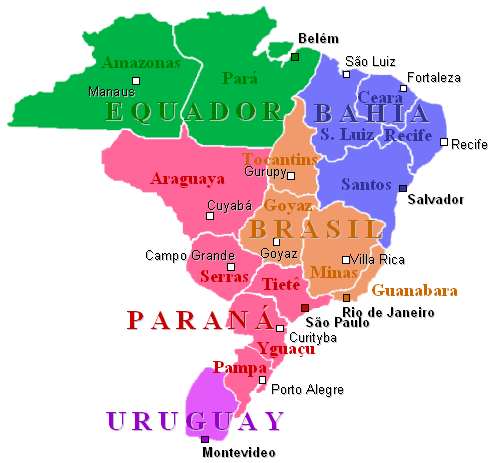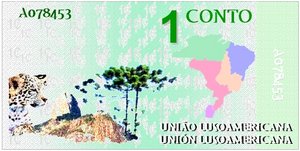Lusoamerican Union

| |

|
Member States
The Lusoamerican Union comprises those nations which were Portuguese colonies in the 16th century. The Union - a fellowship of political, cultural and economic coöperation - became formal in 1900. Member states are striving for a common currency.
The Union (also known as LAU, or more frequently as ULA from the Portuguese-language name União Lusoamericana) is composed of the following states:
| Bahia | Brasil | Equador | Paraná | Uruguai |
 |
 |
The badge of the ULA - the constellation of the Southern Cross, or Cruzeiro do Sul - represents the member countries in their approximate geographical positions:
| EQ | |||
| BI | |||
| PA | BR | ||
| UR |
Geography

Member Countries, their States and State Capitals
History
The Lusoamerican states have a complex political history. A brief overview follows:
- 1809 Portuguese King Pedro imprisoned by Napoleon. Joseph Bonaparte put on throne.
- 1811 The Republic of Paraná declares independence in July. Bahia and Fortaleza declare independence in August, but Rio de Janeiro remains royalist.
- 1814 King Pedro returns to Portugal with Napoleon's defeat.
- 1818 Northeastern colonies return to crown. Paraná rebels, as well as many Northeasterners, who hide in the jungles and Castilian territories.
- 1819 Portugal invades Uruguai, supporter of Paraná.
- 1822 Paraná defeats royalists at Rio de Janeiro and frees Uruguay. The Republic of Brasil is formed, including Rio de Janeiro and Uruguay, as Paraná's protectorate.
- 1824 Republic of Equador proclaimed in spite of Portuguese campaigns against rebels.
- 1827 Paraná hands Uruguay back to Riu d'Archent.
- 1846 Portuguese parliament bans slavery. The Northeastern insurgents form the Republic of Bahia.
- 1860 Portugal recognizes the de facto independence of Equador and Bahia.
- 1900 Lusoamerican Union formed, comprising Bahia, Brasil, Equador, Paraná and and the autonomous province of Uruguai in Riu d'Archent.
- Bahia and Brasil are parliamentary republics, Equador and Paraná are presidentialist republics, and Uruguay is an autonomous state of Riu de l'Argent.
| Period | Bahia | Brasil | Equador | Paraná | Uruguay |
|---|---|---|---|---|---|
| 1500-1811 | Port. colony | Port. colony | Port. colony | Port. colony | Arag. colony |
| 1811-1818 | Independent w/ Fortaleza |
Royalist as Rio de Janeiro |
Port. colony | Republic | Arag. colony |
| 1818-1822 | Port. colony w/ Fortaleza |
Royalist as Rio de Janeiro |
Port. colony | Republic | Colony Port. after 1819 |
| 1822-1824 | Port. colony | Republic | Port. colony | Republic | Paraná Protectorate |
| 1824-1827 | Port. colony | Republic | Republic | Republic | Paraná Protectorate |
| 1827-1846 | Port. colony | Republic | Republic | Republic | Back to Riu de L'Argent |
| 1846-pres. | Republic | Republic | Republic | Republic | Autonomous state |
Language
Tha member states of the Lusoamerican Union, except for Uruguai, share the Portuguese language. Spelling is more etymological than in Portugal and other lusophone countries; the ULA did not take part in the orthographic reform those states initiated in the 1950s. Thus we have Lusoamerican spellings like phthisica 'tuberculosis' (Port. tísica), triumpho 'triumph' (Port. triunfo) and annullar 'annul' (Port. anular). Unlike in all the other members, the Portuguese language is most emphatically not the language of the majority (which is by far and away Aragonese), but it a healthy minority language with a vibrant cultural life along with recognition and limited funding by the autonomous government in Monte Sant Olvidio.
Currency
Currencies in Bahia, Brasil, Equador and Paraná are related as follows, all based on a real worth 0.75 grana of silver:
| Reais: | 1 | 12 | 20 | 60 | 240 | 1,000 | 1,600 | 6,400 | 20,000 | 1,000,000 |
|---|---|---|---|---|---|---|---|---|---|---|
| Bahia | Rs | - | - | - | - | - | Es escudo |
P peça |
- | - |
| Brasil | R$ | - | - | - | - | - | B$ brasão |
C$ cruzeiro |
- | - |
| Equador | r | s soldo |
- | - | Eq escudo |
- | - | - | - | - |
| Paraná | r$ | - | vintém | tostão | pataca | $ mil-réis |
- | - | dobrão | conto de réis |
The member states of the Lusoamerican Union have been planning a common currency since 1960 at least. Starting in 2005 a common monetary unit, the conto (¢) has been used by Bahia, Brasil, Equador and Paraná in international trade and exchange. Uruguai cannot follow as it is a part of the greater Riu d'Archent and as such uses the Argentian Reyal (₳), and then the national currencies may be abolished in favour of the single one, even for internal economic affairs. The conto has been defined as 2,400 réis (the real is common among the four countries). Equivalent rates in national denominations are:
- Bahia: 3/8 P = 1.5 Es
- Brasil: 3/8 C$ = 1.5 B$
- Equador: 10 Eq
- Paraná: 2$400
- FK: 0.978+£ = 19s 6.78+d
| Monetary Unit | Symbol | Silver per Unit |
| 1 conto | ¢ | 1,800 gr |
| = 20 tostões | Ŧ | 90 gr |
| = 240 denários | ð | 7.5 gr |
| = 2,400 réis | r | 0.75 gr |
| The 1-conto bill has the Southern Cross badge on the front ... | 
|
| ... while the back shows a map of the ULA beside a jaguar, the Sugar Loaf and Araucaria pines | 
|

